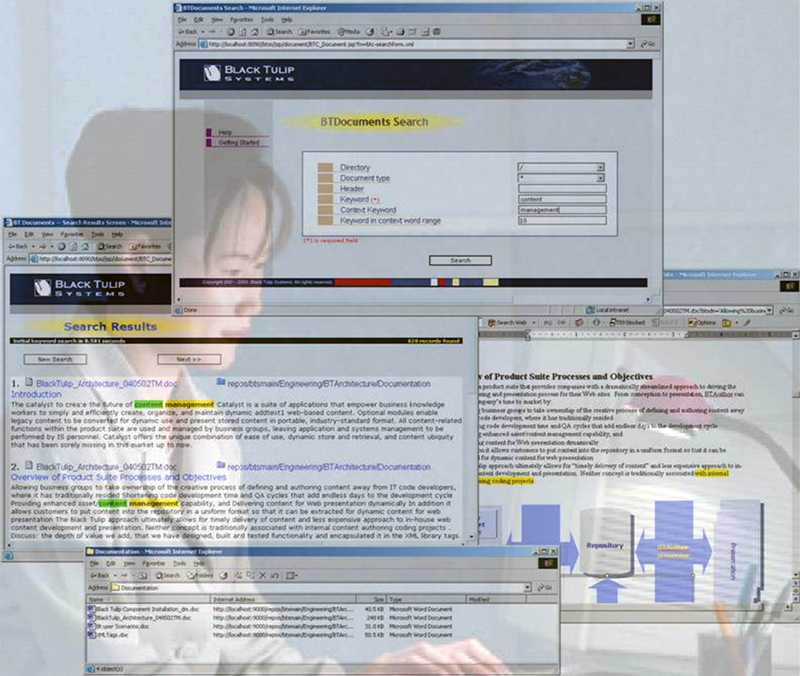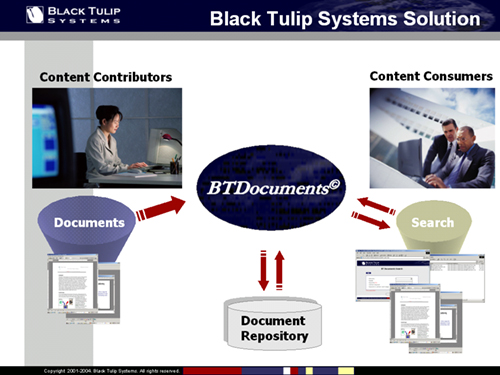
Managing Content in a Matter of Minutes
Originating Technology/NASA Contribution
NASA software created to help scientists expeditiously search and organize their research documents is now aiding compliance personnel, law enforcement investigators, and the general public in their efforts to search, store, manage, and retrieve documents more efficiently.
Developed at Ames Research Center, NETMARK software was designed to manipulate vast amounts of unstructured and semi-structured NASA documents. NETMARK is both a relational and object-oriented technology built on an Oracle® enterprise-wide database. To ensure easy user access, Ames constructed NETMARK as a Web-enabled platform utilizing the latest in Internet technology. One of the significant benefits of the program was its ability to store and manage mission-critical data.
Partnership
Black Tulip Systems Corporation, of San Jose, California, was given the opportunity to preview the NETMARK software in November 2002. Right away, the company knew that the NASA-developed technology would be the perfect complement to its current product offerings. The addition of the NETMARK technology could allow the company to grow the business and access a much larger unstructured document market.
Ames subsequently licensed the NETMARK software to Black Tulip Systems to make the tool available to people and organizations that need rapid searching of computer networks and systems. Black Tulip Systems has since enhanced NETMARK by adding more robust search tools and user-friendly interfaces, and by speeding up the processing time. “For non-technical users, the ease-of-use and increased speed will bring important evaluations to a faster conclusion,” notes Black Tulip Systems’ President and Chief Executive Officer Ted Munnich.
Product Outcome
With the integration of NETMARK with Black Tulip Systems’ existing document-processing practices, the company is bringing ownership back to content contributors by reducing the technology- and process-related complexities associated with retrieval and authoring. The outcome is being marketed as BTDocuments,© a revolutionary document index and search platform designed to convert unstructured and semi-structured documents into useful and easily accessed information. Indexed documents can be searched by keyword, keyword in context, and document type. Proximity and Boolean searches are built-in features of the search engine.
BTDocuments encompasses four key features that make document retrieval practical. The first feature “Sophisticated Search and Indexing” permits BTDocuments to search on anything from sections, titles, and headings to search strings, within locally stored documents. The second feature “Flexible Document Collection” lets BTDocuments support the most popular Microsoft® Office applications, like Word, Excel, and PowerPoint, as well as many other document formats. The third feature “Direct Navigation” lets users jump from the Web pages straight into the document, right to the paragraph they want. The fourth feature “Automated Target Document Assembly” allows BTDocuments to generate a new document from a search result set and store that document for future use.
As a business or document application grows, users can easily move from the desktop, to a network, and then all the way up to an enterprise with three scaleable versions of BTDocuments that are platform and database independent. For instance, a small professional group that starts out with one or two consultants or lawyers can easily maintain their document system and grow this system as their business grows.
A feature called BTEngine© is the underlying technology on which BTDocuments is built. BTEngine processes business logic combined with user-interface stored in eXtensible Markup Language (XML) files to present end-users’ standard screens, represented as entry screens or result pages, ensuring accurate content storage and easy integration into the customer environments.
Also built on BTEngine, the BTAuthor© tool allows authors to create and store new content using native desktop authoring tools such as Word, so that their current processes or work environment are not interrupted. The authors are also capable of converting legacy documents of any type and format into useful knowledge bases.
Employing a unique approach called application encapsulation, BTAuthor enables business users across any enterprise to create and manage their own content in a small fraction of the time possible with existing Enterprise Content Management (ECM) technology, and without information technology (IT) involvement. According to Black Tulip Systems, ECM products have primarily concentrated on data storage and presentation. The company added that the content-authoring functionality provided by these products involves the use of programming or scripting languages such as Java,™ Practical Extraction and Reporting Language (Perl), or tool command language (TCL) to create authoring applications. This activity requires IT development to produce the content-authoring interfaces. Black Tulip Systems notes that a separate authoring interface is required for each type of content authored, with each taking an IT department about 5 days to design, code, and test. The company, which has whittled this time down to a matter of minutes with the Black Tulip “Solution Suite,” asserts that the complexity behind this interface-production process leaves the enterprise “in the unenviable position of spending significant capital per year supporting content contributors on a recurring basis.”
“Existing solutions essentially remove the author’s ownership and creativity and place these activities in the IT department’s hands,” according to Munnich. “This transfer results in a skills mismatch within a group not chartered or staffed to ensure quality for a wide range of content delivery media, including the organization’s most visible symbol, its Web site.”
Black Tulip Systems’ solutions have proven to substantially improve productivity. The company has keyed in on publishing and public relations firms, health care providers, insurance groups, law enforcement offices, educational institutions, and government entities as valued customers. The simplicity and cost-effectiveness of the software has made it a welcomed addition for general users, as well.
Oracle® is a registered trademark of Oracle Corporation.
BTDocuments,© BTEngine,© and BTAuthor© are copyrights of Black Tulip Systems Corporation.
Microsoft® is a registered trademark of Microsoft Corporation.
Java™ is a trademark of Sun Microsystems, Inc.

BTAuthor,© enables business users to create and manage their own content in a small fraction of the time possible with existing Enterprise Content Management technology, and without involvement from the information technology department.

A NASA program that allows for rapid searching of computer networks and systems is the basis for BTDocuments,© a document index and search platform designed to convert unstructured and semi-structured documents into useful and easily accessed information.













